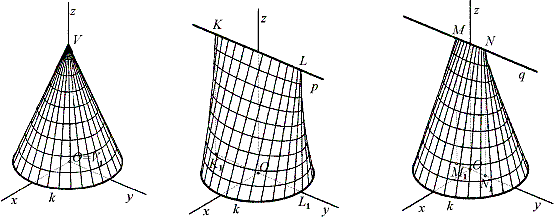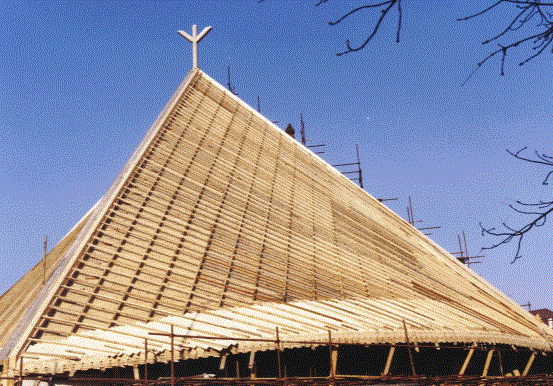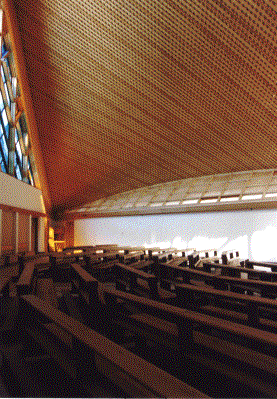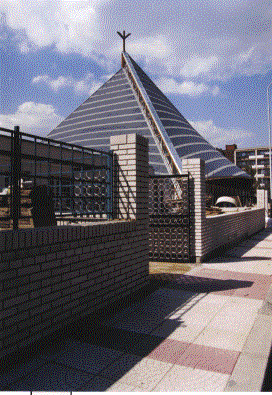|
V Konferencja Matematyka w naukach technicznych i przyrodniczych Krynica, 5-7 czerwca 2000 The Geometric Models of RoofingKamil Maleček, Dagmar Szarková Czech Technical University, Slovak Technical University kamil@kmat.fsv.cvut.cz, szarkova@sjf.stuba.sk
Abstract
|
|
|
|
Fig. 1. Fig. 2. Fig. 3. |
|
|
|
Fig. 1a. Fig. 2a. Fig. 3a. |
Planar
cuttings of a surface by planes parallel to the plane ![]() are
contour lines. The ground views of contour lines are presented in
the Figs. 1a, 2a and 3a, which are the
orthographic views of contour lines to the plane
are
contour lines. The ground views of contour lines are presented in
the Figs. 1a, 2a and 3a, which are the
orthographic views of contour lines to the plane ![]() .
.
In
the case, when the surface is the conical surface, the ground
views of contour lines are concentric circles with a reducing
radius. The contour line in a plane of the vertex V is
reducing to a point and the ground view of this point is the point
V1. Every ground view of a contour line in the
plane ![]() is
an image of the circle k in the homothety with the centre V1
and with a suitable chosen coefficient.
is
an image of the circle k in the homothety with the centre V1
and with a suitable chosen coefficient.
In the case, when the surface is a segment of a conoid, then the ground views of contour lines are ellipses with the common major vertices K1, L1 and with a reducing size of the semi-minor axis. The line segment K1L1 is the ground view of a contour line in the plane of the line p. Every ground view of a contour line is an image of the circle k in the axial affinity with an axis p1 and with a suitable chosen characteristic.
Finally in the case, when a surface is a segment of the Štramber's pipe, then the ground views of contour lines are ellipses with a reducing size of the both semi-axes. Only the ground view of contour line in a plane of the line q is the line segment M1N1. Every ground view of contour line is an image of the circle k in a transformation, which is a called change of metrics on the both axes.
The ground views of contour lines are images of the circle k in affine transformations in all cases. So that, the surfaces, which we used as the geometric model of roofing, are created as follows:
The
circle k continuously transforms by any of the introduced
transformations and translates in the direction perpendicular to
the plane ![]() .
.
Mathematical description of transformations and the geometric model of roofing
In
the Euclidean space E3,
choose a Cartesian coordinates system ![]() O, x, y, z
O, x, y, z![]() ,
so that the centre of the circle k is at the origin O
and the plane
,
so that the centre of the circle k is at the origin O
and the plane ![]() coincides
with the xy-plane. In the case of the conoid resp. the Štramber's
pipe is the line p resp. line q in the plane
yz and parallel to the axis y.
coincides
with the xy-plane. In the case of the conoid resp. the Štramber's
pipe is the line p resp. line q in the plane
yz and parallel to the axis y.
In the plane xy are above described transformations defined by the matrix
| a, b are real constants. |
If X' = [x1, x2] is the image of the point X = [x, y] , then
 |
and then
| (1) | x1 = ax , x2 = by . |
If a = b = 1 , then transformation is an incidence and we will not deal with them.
Choosing the constants a, b , then we get:
i) b
= a , a ![]() 0 ,
a
0 ,
a ![]() 1 .
1 .
The transformation (1) is the homothety with the centre in the origin O. If a = 0, then the transformation is singular, because all the points of the plane xy will be projected to the origin O .
ii) a
is real constant, a ![]() 0 ,
a
0 ,
a ![]() 1 ,
b = 1 .
1 ,
b = 1 .
The
transformation (1) is an axial affinity with the axis y .
When a = 0 , then the transformation is singular and
points of the plane will be project on the y axis.
iii)
a ![]() b ,
(a,b)
b ,
(a,b) ![]() (1,1) .
(1,1) .
The transformation (1) is the change of metrics on the both axes. This transformation is singular in the case, when either a = 0 or b = 0 , like in the affine transformation.
Now, let a, b in the matrix A be linear functions of the argument v :
| (2) | a = a(v) , b = b(v) . |
The circle k is defined by the parametric representation
| (3) |
Ground views of the contour lines obtained by the transformation of the circle k have, according to (1), parametric representation
and their translation in the
direction perpendicular to the plane ![]() is
defined by the vector (0, 0, v) . The
surface with the parametric representation
is
defined by the vector (0, 0, v) . The
surface with the parametric representation
| (4) |
we obtain by composition of the both transformations. If we choose the functions a(v), b(v) in the same manner as the constants a, b in i) - iii), then we get:
a) a segment of a conical surface (Fig. 1) for
| (5) | is a nonzero real constant, |
b) a segment of a circular conoid (Fig. 2) for
| (6) |
c) a segment of the Štramber's pipe (Fig. 3) for
| (7) |
For v = p ,
the transformations are singular in all cases. The singular
transformation, as described
it above, enables us to include in conical surface its vertex and
in the case of conoid or the Štramber's pipe enables us to
include a ridge of a roof.
2. Roofing for the ground view of a rectangle
The Fig. 4 illustrates the roofing for ground view of a square by a pavilion roof. The Figs. 5 and 6 illustrate the roofing for ground views of a rectangle with a saddle roof, which is ended by the ridge KL and with hip roof, which is ended by the ridge MN. Ground views of ridges are line segments located on the midline of a rectangle.
|
|
|
Fig. 4. Fig. 5. Fig. 6. |
|
|
|
Fig. 4a. Fig. 5a. Fig. 6a. |
The
perimeter of a ground view is the broken line l in the
plane ![]() .
Contour lines, which are called the laths
.
Contour lines, which are called the laths
in a building practice, are perimeters of the rectangles resp.
squares. Their ground views are presented in Figs. 4a, 5a, 6a.
It is evident, we can obtain that ground views of contour lines in
the sequence from the line l by one of the
transformations i), ii), iii) described, in the last part above.
We would create a mathematical description of the geometric model for roofing constructions with help of the parametric representation (4), where we would substitute the parametric representation of the circle k with the parametric representation of the line segments, which create the line l .
3. Roofing for the ground view of a square and a circle by segments of a hyperbolic paraboloid
In the Figs. 7 and 8, the roofing for the ground view of a square, is showed. The ridges KL and MN end roofing. For now, the ground views of the ridges are on a diagonal of a square.
|
|
|
Fig. 7. Fig. 8. Fig. 9. |
|
|
|
Fig. 7a. Fig. 8a. Fig. 9a. |
We choose the Cartesian coordinates system that the origin O will be the centre of a square or of a rectangle l and the axis y will be a diagonal incident with the ground view of a roofing's ridge. Ground views of contour lines are images of the perimeter l of a square, which is transformed according to ii) or iii) (see Fig. 7a or Fig. 8a). It is evident, the roofing is created by four shells in the both case. The geometric model for this roofing is formed by four segments of a hyperbolic paraboloid. We obtain a pavilion roof by the composition of the transformation i) and a translation. This is nothing new for us. This method for roofing ground view of a rectangle is only technical matter.
The
Fig. 9 presents roofing for the ground view of a boundary
circle in the plane ![]() by
a shell. Its geometric model is a segment of a hyperbolic
paraboloid.
by
a shell. Its geometric model is a segment of a hyperbolic
paraboloid.
The boundary curve m of the roofing is the intersection curve of a hyperbolic paraboloid expressed by
and a cylindrical surface expressed by the equation
The curve m is defined by the parametric representation
| (8) |
The circle k is the ground view of the curve m. It is a boundary of the ground view of roofing. The geometric model of roofing is parameterised by the vector function
 |
The isoparametric v-curves are segments of parabolas and four line segments. The isoparametric u-curves are sinusoids on rotational cylindrical surfaces. If v = 0, then the curve reduces to a point. The ground views of isoparametric curves the from vector function (8) are shown in the Fig. 9a .
The hyperbolic paraboloid is a part of the skew surfaces. These surfaces have very good static properties. It enables to construct roofing for the ground view with a larger size by subtle shells without the bracket support. The shells have design of a hyperbolic paraboloid. This part of the paper with photos, that illustrate St. Maria's church in Prague - Strašnice. The church roofing is formed with three shells. Geometric model of the shells is one a segment of the hyperbolic paraboloid. A basic ground view of one segment is a square 20 m by 20 m. The thickness of the roofing's lateral surface is 8 cm.
|
|
|
Fig. 10. |
|
|
|
|
Fig. 11. |
Fig. 12. |
Fig. 10 shows the roofing's lateral surface of the construction. Fig. 11 describes interior of the roofing. In both views the laths, which represent geometric model formed with basic lines from both systems of a hyperbolic paraboloid , can be seen very nicely. Fig. 12 is a complete view of the St. Maria's church. It was built in 1992 by ing. Hrdlička according to design of ing.arch. J. Synek.
The visit of the St. Maria's church before konference - 3.6.2000








